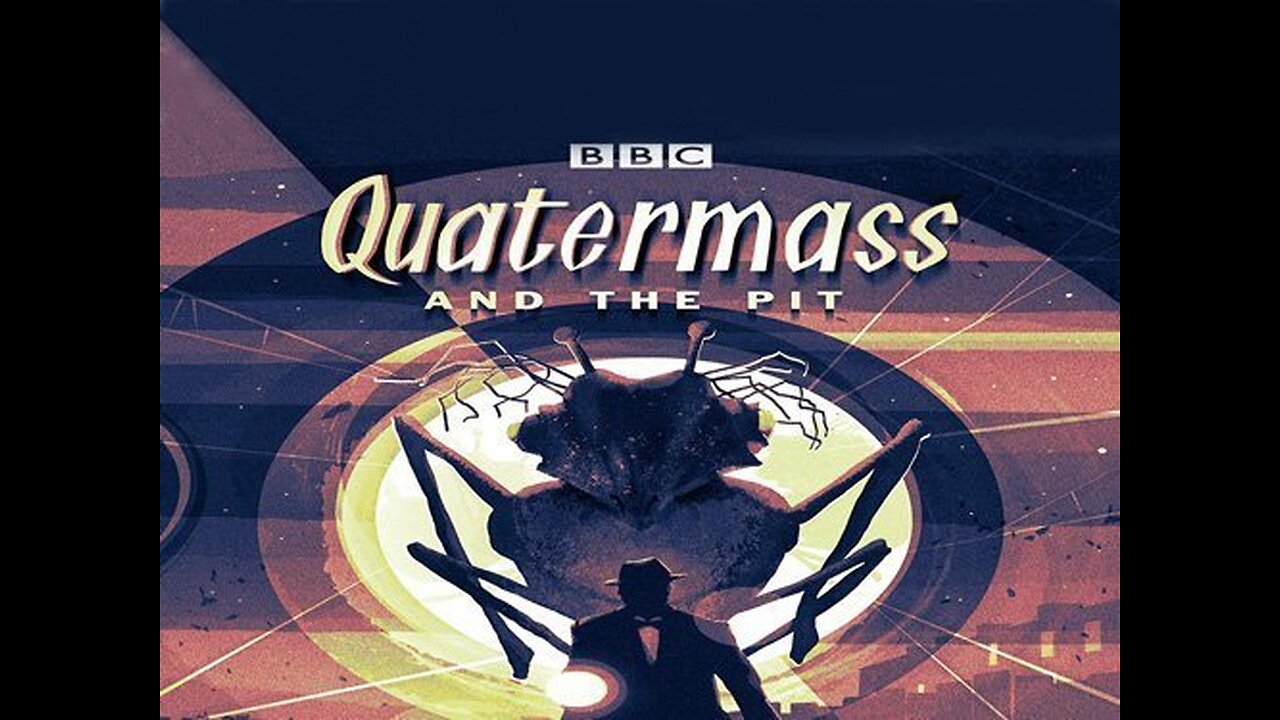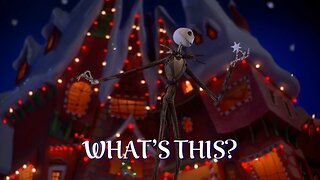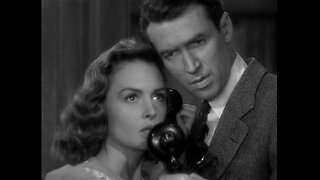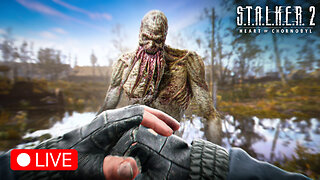Premium Only Content

QUATERMASS AND THE PIT (1958-1959)--colourised serial
QUATERMASS AND THE PIT is a British television science-fiction serial transmitted live by BBC Television in December 1958 and January 1959. It was the third and last of the BBC's Quatermass serials, although the chief character, Professor Bernard Quatermass, reappeared in a 1979 ITV production called Quatermass. Like its predecessors, Quatermass and the Pit was written by Nigel Kneale.
The serial continues the loose chronology of the Quatermass adventures. Workmen excavating a site in Knightsbridge, London, discover a strange skull and what at first appears to be an unexploded bomb. Quatermass and his newly appointed military superior at the British Rocket Group, Colonel Breen, become involved in the investigation when it becomes apparent that the object is an alien spacecraft. The ship and its contents have a powerful and malignant influence over many of those who come in contact with it, including Quatermass. He concludes that millions of years in the past the aliens, probably from Mars, had abducted pre-humans and modified them to give them psychic abilities much like their own before returning them to Earth, leaving a genetic legacy which is responsible for much of the war and racial strife in the world.
The serial has been cited as having influenced Stephen King[1] and the film director John Carpenter.[2] It featured in the 100 Greatest British Television Programmes compiled in 2000 by the British Film Institute, which described it as "completely gripping".[3] is a British television science-fiction serial transmitted live by BBC Television in December 1958 and January 1959. It was the third and last of the BBC's Quatermass serials, although the chief character, Professor Bernard Quatermass, reappeared in a 1979 ITV production called Quatermass. Like its predecessors, Quatermass and the Pit was written by Nigel Kneale.
The serial continues the loose chronology of the Quatermass adventures. Workmen excavating a site in Knightsbridge, London, discover a strange skull and what at first appears to be an unexploded bomb. Quatermass and his newly appointed military superior at the British Rocket Group, Colonel Breen, become involved in the investigation when it becomes apparent that the object is an alien spacecraft. The ship and its contents have a powerful and malignant influence over many of those who come in contact with it, including Quatermass. He concludes that millions of years in the past the aliens, probably from Mars, had abducted pre-humans and modified them to give them psychic abilities much like their own before returning them to Earth, leaving a genetic legacy which is responsible for much of the war and racial strife in the world.
The serial has been cited as having influenced Stephen King[1] and the film director John Carpenter. It featured in the 100 Greatest British Television Programmes compiled in 2000 by the British Film Institute, which described it as "completely gripping".
BACKGROUND
The Quatermass Experiment (1953) and Quatermass II (1955), both written by Nigel Kneale, had been critical and popular successes for the BBC, and in early 1957 the corporation decided to commission a third serial. Kneale had left the BBC shortly before, but was hired to write the new scripts on a freelance basis.
The British Empire had been in transition since the 1920s, and the pace accelerated in the wake of the Second World War. More and more member states demanded independence, and a series of crises erupted during the 1950s, including the 1952 Mau Mau Uprising in Kenya and the Suez Crisis of 1956. During the same period immigration into Britain from the Indian subcontinent and the Caribbean was on the increase, causing some resentment among elements of the British. At the time Kneale was working on his scripts black communities in Nottingham and London came under attack from mobs of white Britons. Kneale disdained most science-fiction works of the 1950s as overly escapist, and preferred to base his plots on current events. Kneale became keen to develop the serial as an allegory for the emerging racial tensions which culminated in the Notting Hill race riots of August and September 1958.
Kneale was also inspired by the rebuilding of London in the 1950s. Huge pits were dug in the process of erecting new structures, and the digs found unexploded ordnance from the Blitz and the occasional Romano-British ruin. Kneale thought: "What if they uncovered a spaceship?"
PLOT
Workmen discover a pre-human skull while building in the fictional Hobbs Lane (formerly Hob's Lane, Hob being an antiquated name for the Devil) in Knightsbridge, London. Dr Matthew Roney, a palaeontologist, examines the remains and reconstructs a dwarf-like humanoid with a large brain volume, which he believes to be a primitive man. As further excavation is undertaken, something that looks like a missile is unearthed; further work by Roney's group is halted because the military believe it to be an unexploded Second World War bomb.
Roney calls in his friend Professor Bernard Quatermass of the British Rocket Group to prevent the military from disturbing what he believes to be an archaeological find. Quatermass and Colonel Breen become intrigued by the site. Breen has recently been appointed, despite Quatermass's objections, to be nominally his deputy but in reality to lead the Rocket Group. As more of the artefact is uncovered additional fossils are found, which Roney dates to five million years ago, suggesting that the object is at least that old. The interior is empty, and a symbol of six intersecting circles, which Roney identifies as a pentacle, is etched on a wall that appears to conceal an inner chamber.
The inner chamber wall of the object is so hard that even a borazon boron nitride drill makes no impression, and when the attempt is made, vibrations cause severe distress to people around the object. Quatermass interviews local residents and discovers reports of ghosts and poltergeists have been common in the area for decades. An hysterical soldier is carried out of the object, claiming to have seen a dwarf-like apparition walk through the wall of the artifact, a description that matches a 1927 newspaper account of a ghost.
Following the drilling attempt, a hole opens up in the object's interior wall. Inside, Quatermass and the others find the remains of insect-like aliens resembling giant three-legged locusts, with stubby antennae on their heads giving the impression of horns. As Quatermass and Roney examine the remains, they theorise the aliens may have come from a planet habitable five million years ago - Mars.
While clearing his equipment from the craft, the drill operator triggers more poltergeist activity, and runs through the streets in a panic until he finds sanctuary in a church. Quatermass and Roney find him there, and he describes visions of the insect aliens killing each other. As Quatermass investigates the history of the area, he finds accounts dating back to mediaeval times about devils and ghosts, all centred on incidents where the ground was disturbed. He suspects a psychic projection of these beings has remained on the alien ship and is being seen by those who come into contact with it.
Quatermass decides to use Roney's optic-encephalogram, a device that records impressions from the optical centres of the brain, and see the visions for himself. Roney's assistant, Barbara Judd, is the most sensitive; placing the device on her, they record a violent purge of the Martian hive to root out unwanted mutations.
Quatermass concludes that in its most primitive phase mankind was visited by this race of Martians. Some apes and primitive pre-humans were taken away and genetically altered to give them abilities such as telepathy, telekinesis and other psychic powers. They were then returned to Earth, and the buried artifact is one of the ships that had crashed at the end of its journey. With their home world dying, the aliens had tried to change humanity's ancestors to have minds and abilities similar to their own, but with a bodily form adapted to life on Earth; however, the aliens had become extinct before completing their work. As the human race bred and evolved, a percentage retained their psychic abilities which surfaced only sporadically. For centuries the buried ship had occasionally triggered those dormant abilities, which explained the reports of poltergeists; people were unknowingly using their own telekinesis to move objects around, and the ghost sightings were traces of a racial memory.
The authorities, and Breen in particular, find this explanation preposterous despite being shown the recording of Barbara's vision. They instead suggest that the craft is a buried remnant from the London Blitz: a Nazi propaganda weapon, with the alien bodies fakes designed to create a panic. They decide to hold a media event to stem the rumours that are already spreading.
Quatermass warns that if implanted psychic powers survive in the human race, there could also still be an ingrained compulsion to enact the "Wild Hunt" of a race purge, but the media event goes ahead regardless. The power cables that string into the craft fully activate it for the first time, and glowing and humming like a living thing it starts to draw upon this energy source and awaken the ancient racial programming. Those Londoners in whom the alien admixture remains strong fall under the ship's influence; they merge into a group mind and begin a telekinetic mass murder of those without the alien genes, an ethnic cleansing of those the alien race mind considers to be impure and weak.
Breen stands transfixed and is eventually consumed by the energies from the craft as it slowly melts away and an image of a Martian "devil" floats in the sky above London. Fires and riots erupt. Quatermass himself succumbs to Martian influence and attempts to kill Roney, who lacks the alien gene and is immune to alien influence. Roney manages to shake Quatermass out of his trance, and remembering the legends of demons and their aversion to iron and water, proposes that a sufficient mass of iron connected to wet earth may be sufficient to short-circuit the apparition. Quatermass acquires a length of iron chain and tries to reach the "devil" but succumbs to its psychic pressure. Roney manages to walk up to the apparition and hurls the chain at it, resulting in him and the spacecraft being reduced to ashes.
At the conclusion of the final episode Quatermass gives a television broadcast, at the end of which he delivers a warning directly to camera: "Every war crisis, witch hunt, race riot, and purge... is a reminder and a warning. We are the Martians. If we cannot control the [Martian] inheritance within us, this will be their second dead planet".
Cast
For the third time in as many serials the title role was played by a different actor, this time by André Morell; the part had initially been offered to Alec Clunes, but he declined. Morell had a reputation for playing authority figures, such as Colonel Green in The Bridge on the River Kwai (1957), and had previously worked with Kneale and Cartier when he appeared as O'Brien in their BBC television adaptation of Nineteen Eighty-Four (1954). He had been the first actor offered the part of Quatermass, for the original serial The Quatermass Experiment in 1953; he turned the part down. Morell's portrayal of Quatermass has been described as the definitive interpretation of the character.
Colonel Breen was played by Anthony Bushell, who was known for various similar military roles – including another bomb disposal officer in The Small Back Room (1949) – and preferred to be addressed as "Major Bushell", the rank he held during the Second World War. Roney was played by Canadian actor Cec Linder, John Stratton played Captain Potter, and Christine Finn played the other main character, Barbara Judd. Finn went on to provide the voices for various characters in the popular 1960s children's television series Thunderbirds.
For the first time, Kneale used a character from a previous serial other than Quatermass himself, the journalist James Fullalove from The Quatermass Experiment. The production team had hoped that Paul Whitsun-Jones would be able to reprise the part; he was unavailable and Brian Worth was cast instead. Michael Ripper appeared as an army sergeant; he had been in Hammer Film Productions' adaptation of the second Quatermass serial, Quatermass 2, the previous year
CHAPTERS
1 "The Halfmen"
2 "The Ghosts"
3 "Imps and Demons"
4 "The Enchanted"
5 "The Wild Hunt"
6 "'Hob'"
-
 2:48
2:48
Steven Crowder
17 hours agoCROWDER CLASSICS: What’s This? | Nightmare Before Kwanzaa (Nightmare Before Christmas Parody)
220K12 -
 33:49
33:49
Quite Frankly
14 hours agoThe Christmas Eve Midnight Telethon
16.9K2 -
 2:12:46
2:12:46
Price of Reason
13 hours agoAmber Heard BACKS Blake Lively Lawsuit Against Justin Baldoni! Is Disney CEO Bob Iger in TROUBLE?
8.04K5 -
 1:01:17
1:01:17
The StoneZONE with Roger Stone
8 hours agoChristmas Edition: Why the Panama Canal is Part of the America First Agenda | The StoneZONE
51.3K22 -
 LIVE
LIVE
LFA TV
18 hours agoLFA TV CHRISTMAS EVE REPLAY
1,267 watching -
 4:33:48
4:33:48
tacetmort3m
1 day ago🔴 LIVE - THE ZONE KEEPS PULLING ME BACK - STALKER 2 - PART 15
44.3K12 -
 22:45
22:45
Brewzle
15 hours agoI Went Drinking In A Real Bourbon Castle
32.4K3 -
 48:36
48:36
PMG
1 day ago $2.50 earned"Parkland Parent Speaks Out On Kamala Harris Using Victims"
25.2K3 -
 4:06
4:06
The Lou Holtz Show
14 hours agoCoach Lou Holtz’s Heartfelt Christmas Message 🎄 | Family, Faith & Notre Dame Spirit 💚 #christmas
16.8K -
![ROSEANNE BARR - Her Journey, TRUMP, and the MAGA GOLDEN AGE! [INTERVIEW]](https://1a-1791.com/video/s8/1/M/m/B/2/MmB2v.0kob.1-small-ROSEANNE-BARR-Her-Journey-T.jpg) 51:35
51:35
Dr Steve Turley
1 day ago $18.71 earnedROSEANNE BARR - Her Journey, TRUMP, and the MAGA GOLDEN AGE! [INTERVIEW]
54K51